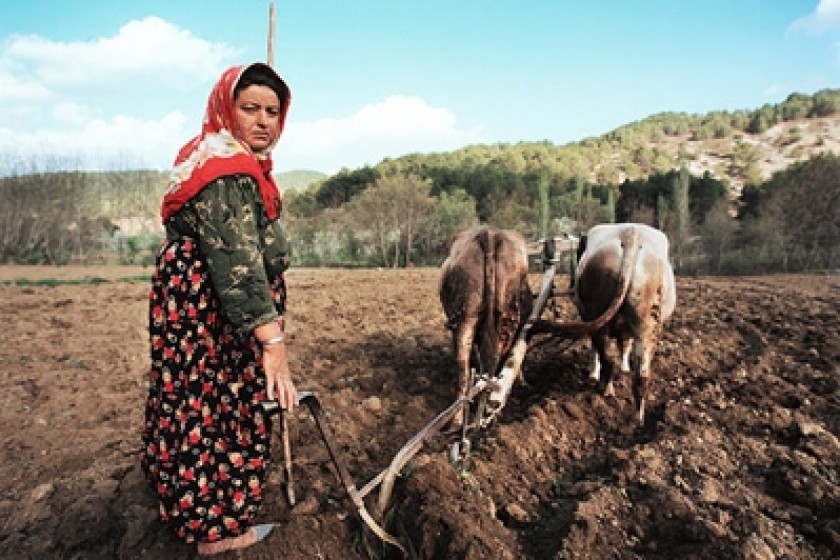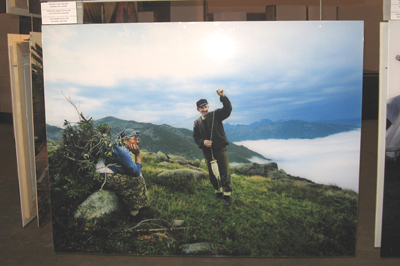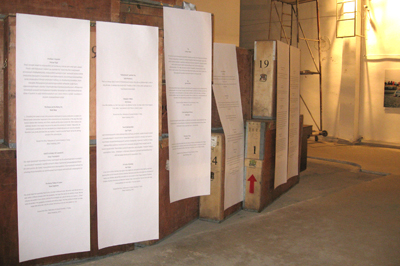
Ebru – Weaving the Myth of a Europeanizing Turkey
This May, we had the opportunity to see two photo exhibits here in Yerevan. One was an extensive exhibit of the works by the New York-based Turkish photographer Attila Durak on display at the Armenian Center for Contemporary Experimental Art (ACCEA) entitled "Erbru – Reflections of Cultural Diversity in Turkey". The other presented the works of French-Armenian photographer Max Sivaslian entitled "We Once Lived There..." Both are related in some way to the issue of ethnic (religious) minorities living in Turkey.
Despite the fact that Sivaslian's photos are far removed from being documentary testimonies, that main aim of the exhibition was clear. "We Once Lived There" refers to those locales (villages, towns, neighbourhoods) where Armenians once called home – from Van to Diyarbekir and even Istanbul. Now, others live in their former homes – Kurds, Turks, and Assyrians. The photographer firstly strives to reflect on the disappearance of Armenians from these locations; they either leave or are Islamicized.
More extensive in scope was the ACCEA exhibition. It was a sampling of the thousands of photos that Durak took over the course of seven years while travelling to various regions of Anatolia. The works include individual portraits and group shots. The project was turned into a book in 2007 with its own website (www.ebruproject.com). The exhibition has also been shown in Germany, France, Switzerland and the U.S., in addition to Turkey.
The theme of my article is the Ebru project. The word "weaving" in the title may seem out of place for a photographic project but the photos, in the book just as in the exhibit, are incorporated in a diverse and abundant textual weaving. I'll speak about this in more detail later on.
The Story of the Photographer
From his statement and the story of a journey, it is evident that the term "reflections" not only does not reflect the objective of the project or the scope of its ambitions, that perhaps took shape gradually and were formed in the texts making up the project, but also its initial motivating force of which Durak speaks. Or, which seems more probable, the "reflections" merely refer to the photographs (even today a photo can still be regarded as a simple reflection of reality), and the observational work is totally relegated to the texts.
In reality, it is clear that the consistent work of constructing meaning is severely separated from the visual material, where the humble role of "witness" is reserved to the latter. In the tens of pages written by over twenty authors, not one of the photos is discussed. Of course, this allows one to avoid the difficult work of discussing the extensive variety of the photos, while at the same time, by telling one's own stories and formulating one's own commentaries, preventing or marginalizing other interpretations.
The following thought of Durak is descriptive of the photographer's initial intention and the overall project in general. "I wanted to tell a different story than the ones that had been already told; a story in which the images, when put together, would constitute the sentences and paragraphs...I wanted to tell a story that would be about 'today', yet would also reflect the sorrows of yesterday and the hopes for tomorrow." Thus, in addition to the fact that the photos are merely individual elements that the photographer freely masters to constitute his sentences and paragraphs (in this project the photos are only nameless "faces", "eyes", in the end, " the current colors of Turkey" ), right from the start a promising future is predicted. The 'today' is given meaning, by being placed between yesterday's sorrows and tomorrow's hopes.
It is only in this prospect that the numerous episodes of violence and discrimination in his story, "people on the brink of extinction due to exile and assimilation", must be understood. As to how "many people who heard that our endeavor was a book and exhibition project about cultural diversity did not want to have their picture taken. Those who I did photograph requested that their ethnic identities not be revealed."
Usually, more than focusing on details, the photographer prefers to generalize. He is astounded by "the beauty of diversity" and is filled with respect by the people's "will to survive". At times he feels the anger associated with "certain irreversible loss", "the pain inflicted on people just because they were different" and from the feeling of homelessness fated to certain groups of the population.
His photographs reflect the diversity that has taken root in different cultural identities, while at the same time, "underlining the general humanity that unites us. I wanted Ebru to emphasize what sounds so simple and obvious when put into words: these photographs (with one exception) are human portraits—they are the portraits of people who laugh when happy, who cry over the loss of a loved one, who fall in love, who work, hope, worry and dream..."
 Decades ago Roland Barthes observed how "The Great Family of Man" photo exhibition refers to the ambiguous myth of human "community": "This myth functions in two stages: first the difference between human morphologies is asserted, exoticism is insistently stressed, the infinite variations of the species, the diversity in skins, skulls and customs are made manifest, the image of Babel is complacently projected over that of the world. Then, from this pluralism, a type of unity is magically produced: man is born, works, laughs and dies everywhere in the same way; and if there still remains in these actions some ethnic peculiarity, at least one hints that there is underlying each one an identical 'nature', that their diversity is only formal and does not belie the existence of a common mould ... This myth of the human 'condition' rests on a very old mystification, which always consists in placing Nature at the bottom of History. Any classic humanism postulates that in scratching the history of men a little, the relativity of their institutions or the superficial diversity of their skins, one very quickly reaches the solid rock of a universal human nature ... So that I rather fear that the final justification of all this Adamism is to give to the immobility of the world the alibi of a 'wisdom' and a 'lyricism' which only make the gestures of man look eternal the better to defuse them."
Decades ago Roland Barthes observed how "The Great Family of Man" photo exhibition refers to the ambiguous myth of human "community": "This myth functions in two stages: first the difference between human morphologies is asserted, exoticism is insistently stressed, the infinite variations of the species, the diversity in skins, skulls and customs are made manifest, the image of Babel is complacently projected over that of the world. Then, from this pluralism, a type of unity is magically produced: man is born, works, laughs and dies everywhere in the same way; and if there still remains in these actions some ethnic peculiarity, at least one hints that there is underlying each one an identical 'nature', that their diversity is only formal and does not belie the existence of a common mould ... This myth of the human 'condition' rests on a very old mystification, which always consists in placing Nature at the bottom of History. Any classic humanism postulates that in scratching the history of men a little, the relativity of their institutions or the superficial diversity of their skins, one very quickly reaches the solid rock of a universal human nature ... So that I rather fear that the final justification of all this Adamism is to give to the immobility of the world the alibi of a 'wisdom' and a 'lyricism' which only make the gestures of man look eternal the better to defuse them."
In Durak's text that "magical" transition also takes place from diversity to unity, and in this project as well, the desire to somehow neutralize the alarming weight of Turkey's ethnic-religious-cultural diversity is evident. We do not see the same gesture to discover Nature in the depths of history, to declare political and social problems void, in the text of John Berger. If the photographer turns a person nameless, leading him/her to an ethnic-religious grouping or community (even in the photo captions of one person, only their ethnicity or religious affiliation is noted) then, in Berger's case, with the assistance of Empedokles' passage of the four elements of nature (fire, water, earth and air), these groupings are reduced to elements of nature:
"In Anger they have different forms and are all apart, But in Love they come together and are desired by one another. For from these comes everything which was and which is and will be - trees spring up, and men and women and beasts and birds and fish that live in the water and even gods, long-lived and highest in honor. For these themselves exist, and passing through one another they become different; for the mixture interchanges them."
Reflections on Water
The project's theoretical basis, the formulation of the leading principles and the critical analysis of the theories and approaches that are more appropriate in the author's (Ayse Gul Altinay) opinion to deal with the cultural diversity of present-day Turkey we find in the article "Ebru: Reflections on Water".
The painter, who uses the ebru technique, lays down colors on the water surface. Thus, this word "connotes fluidity, movement, connectedness, permeability, and contingency", and as such, is a more promising metaphor for the authors of the project than say the "mosaic" widely used in the past few decades to discuss the old and new dilemmas of cultural politics. In this sense, "Ebru is the search for a new language to make cultural diversity in Turkey visible and intelligible." I consider it important to underline the ambition to make it "visible and intelligible", but, it is my impression that what strikes one in this project is the desire to bury that diversity under the pile of previously known "truths".
On the other hand, during a discussion of the themes "nation and ethnos", "culture and identity" and "multiculturalism", which leads the author to a formulation of the principles of cultural policy, it is possible to notice certain theoretical preconceptions. Thus, what is brought to the forefront is the paradigmatic shift that arose in the 1980s in the study of nation and nationalism that was achieved by such theoreticians as Ernest Gellner and Benedict Anderson. But the denial of the primordiality of nations, the equating of the nation with the ethnicity and other widespread "confusions" is not the final word on the subject as presented in the article. While highly assessing the importance of the modernist interpretation of Gellner and Anderson, we should not overlook its subsequent critique, while at the same time not believing that the other paradigms interpreting nation and nationality (primordialism, ethno-symbolism, etc) have long since been discredited or have pushed out of the current research agendas.
The critique of the essentialized notions of culture, nation and identity is nothing new, but, particularly from the point of view of the Ebru project it would have made sense to pay attention to the fact that they do not work as a tool of cultural homogenization always and everywhere, as presented in the article. Moreover, essentialism can be turned into a way of battling cultural homogenization (strategic essentialism). Gayatri Spivak, for example, accepts the usefulness of essentialist formulations and even its inevitability in certain stages of battling against the consequences of colonialism and neo-colonialism.
 By criticizing "multiculturalism" ("mosaic multiculturalism"), the article's author points out the deficiencies of this model. The individual colors of the mosaic are homogeneous; they are separate from each other by clear-cut borders, that interaction amongst them is prevented and that the feeling of unchanging identity is encouraged. In contrast to the "mosaic", that assumes the homogenization and distinctness of cultures ebru supposedly refers to and encourages their fluidity and permeability. But where are the borders of mutual influence and penetration of cultures and is it merely an innocent and purely beneficial process? This advocating of movement and constant change overlooks the imbalance of the exchange among cultures; it overestimates the reciprocity of mixing in the condition of hierarchy and evident inequality of power relations. These conditions can lead to assimilation and the disappearance of "cultural difference". In reality, that which we find in the stories of the project, overtly or covertly, brings to mind not the spontaneous movement of cultures and their contingent interaction, but rather Turkification and Islamification.
By criticizing "multiculturalism" ("mosaic multiculturalism"), the article's author points out the deficiencies of this model. The individual colors of the mosaic are homogeneous; they are separate from each other by clear-cut borders, that interaction amongst them is prevented and that the feeling of unchanging identity is encouraged. In contrast to the "mosaic", that assumes the homogenization and distinctness of cultures ebru supposedly refers to and encourages their fluidity and permeability. But where are the borders of mutual influence and penetration of cultures and is it merely an innocent and purely beneficial process? This advocating of movement and constant change overlooks the imbalance of the exchange among cultures; it overestimates the reciprocity of mixing in the condition of hierarchy and evident inequality of power relations. These conditions can lead to assimilation and the disappearance of "cultural difference". In reality, that which we find in the stories of the project, overtly or covertly, brings to mind not the spontaneous movement of cultures and their contingent interaction, but rather Turkification and Islamification.
Here, I think it would have been helpful to refer to the contradiction between "cultural diversity" and "cultural difference" and the totally different interpretation of the latter (via the notion of "hybridization") made by Homi Bhabha and for which I do not have the possibility of discussing the details here. Generally, it seems to me that a good starting point for reviewing the conclusions reached and obtaining alternative interpretations of many of the issues touched upon in this project, would be in the field of post-colonial studies ( for understandable reasons this is totally neglected in this project).
Totally unconvincing is the desire to transport the 'Ebru' to a wider context by associating it with the concepts of "cyborg" and "creolozation": Echoing the insistence on the "cyborgness" of all identities, and the "creoleness" of all cultures, we are suggesting that perhaps cultural diversity everywhere is "ebruesque." It instills distrust; in the first place, the universality of the claim – "all identities", "all cultures", "everywhere". Creolozation, by taking on the unique imprint of the Caribbean basin's history and societies, needs further explanation and sometimes tangible reservations if it is to be used in other contexts.
Visitors to this exhibition, contrary to the frequently repetitive and clearly exaggerated claims to the point of being tedious regarding fluidity, interaction and other similar things, see just the name of one ethnic-religious group even under photos depicting several scores of people – "Alevi Kurd", "Laz", etc. This also speaks to the existing void between the empirical data and the interpretative/theoretical efforts in this project.
In turn, the "cyborg" is impossible to separate from the American feminist movements (and theories) and technological revolution with such ease. This portion of the article reminded me of that section of the photographer's story (and photograph) where it mentions a woman plowing the field who has serious objections to doing the work with a tractor. Does she and her fellow villagers have "cyborg" identities?
The unprecedented positive changes taking place in Turkey during recent years, the process of democratization, according to the article's author, results from two forces. The first is the European Union, the pressure it has exacted on Turkey for creating preconditions for membership. The second are the country's academic and political circles. In other words, this academic sector presents itself in this situation as the torchbearer for Turkey's Europeanization.
And it is fully understandable why the Ebru project attempts so wholeheartedly to substantiate Turkey's genuine possibility for its European prospects. Here, it is clear that the policy conducted regarding ethnic-religious minorities is decisive, as well as the recognition of the Armenian Genocide. It is not by accident that the final part of Ayse Gul Altinay's article is completely Armenian related. I will try to reflect on this later.
As I noted above, not one photograph is accompanied by any analysis or commentary in this project. In the name of different stories (coining a phrase form Barthes, "wisdom" and "lyricism"), the rich and interesting visual material is totally neglected. This is an omission that I will try to mollify in a small way in part two of my article.
Photo 1: a Sunni Turk, Ushak, April 2005
Photo 2: Laz, Artashen, August 2003
Photo 3: Exhibition at ACCEA
 Videos
Videos Photos
Photos




Comments (1)
Write a comment